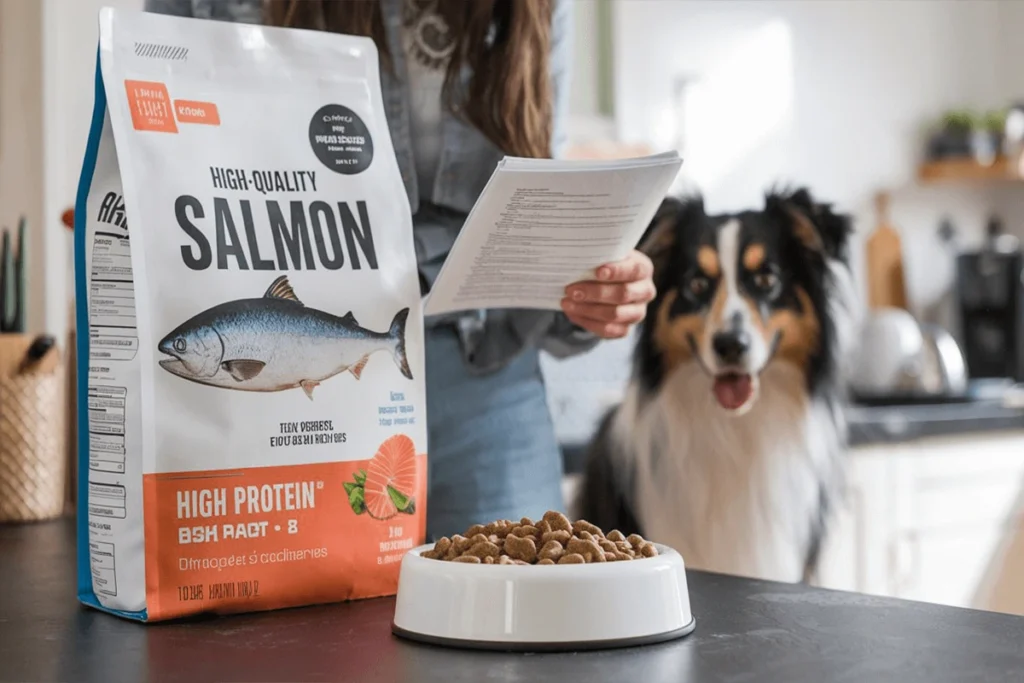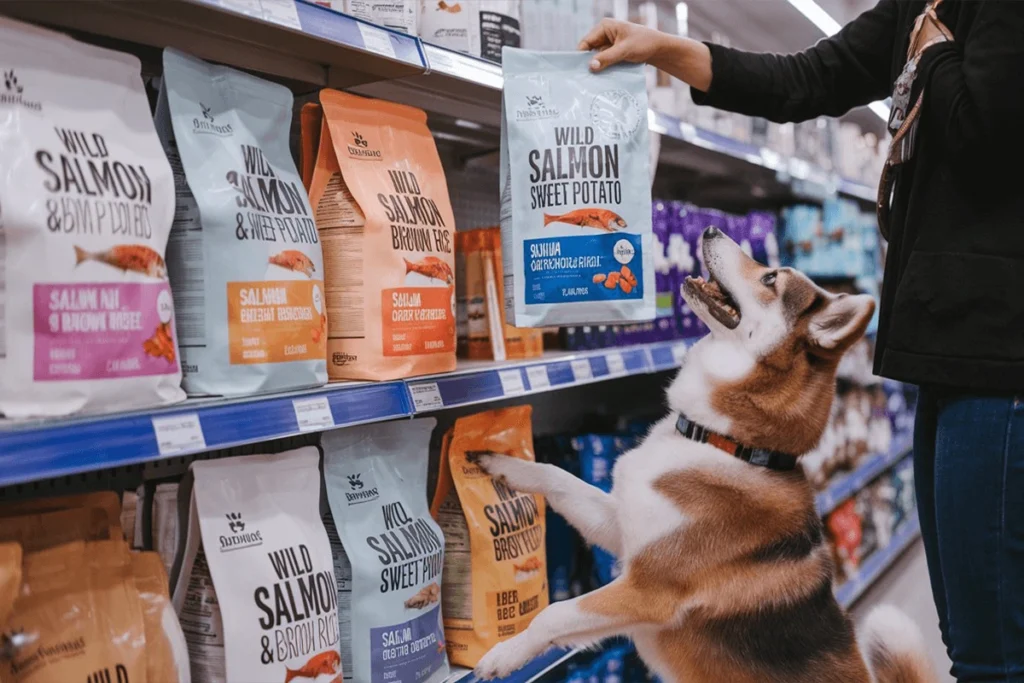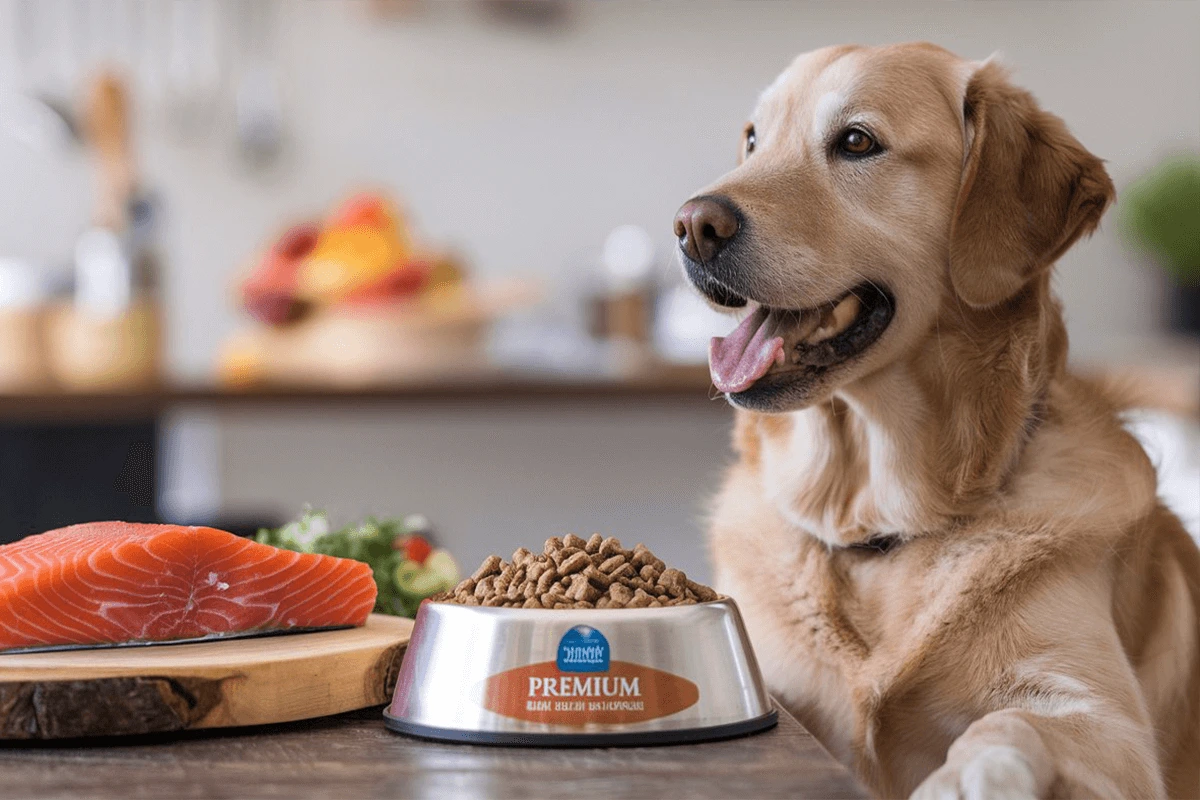Finding the right food for your dog can be a challenge, especially if you have a picky eater. Dog food with salmon has become a popular choice among pet parents because it offers a flavorful and nutritious option that even the fussiest dogs enjoy. Beyond its great taste, salmon-based dog food provides essential nutrients that support overall health, making it an excellent addition to your dog’s diet.
Salmon is a high-quality protein source packed with Omega-3 fatty acids, which promote skin and coat health, reduce inflammation, and support brain function. Many pet owners choose salmon-based food for dogs with sensitive stomachs or food allergies, as it tends to be easier to digest compared to traditional proteins like chicken or beef. Additionally, premium high-protein dog food made with salmon helps maintain strong muscles and energy levels.
In this article, we’ll explore why dog food with salmon is an excellent choice, the benefits it offers picky eaters, and how to choose the best brand for your furry friend. Whether your dog has a sensitive stomach or just prefers a flavorful meal, switching to salmon-based food can be a game-changer. Let’s dive in!
Why Choose Dog Food with Salmon?
Rich in Omega-3 Fatty Acids
Dog food with salmon is one of the best sources of Omega-3 fatty acids, a crucial nutrient that supports your dog’s overall health. Omega-3s play a vital role in skin and coat health, reducing dryness, itchiness, and irritation. If your dog suffers from flaky skin or excessive shedding, switching to a salmon-based diet can lead to a shinier, healthier coat.
These healthy fats also support joint health by reducing inflammation, making dog food with salmon an excellent choice for senior dogs or breeds prone to arthritis. Additionally, Omega-3s contribute to heart health, cognitive function, and immune system support. Puppies and older dogs alike benefit from the brain-boosting effects of these essential fatty acids, improving focus, learning ability, and overall well-being.
When you choose dog food with salmon, you’re not just giving your dog a tasty meal—you’re providing a powerful nutritional boost that enhances their quality of life.
High-Protein and Nutrient-Dense
Dogs thrive on a high-protein diet, and dog food with salmon delivers the protein they need to maintain strong muscles and energy levels. Unlike some lower-quality protein sources, salmon is lean yet packed with essential amino acids that help with muscle development, tissue repair, and overall body function. Active dogs, working breeds, and growing puppies especially benefit from the high-protein content of salmon-based food.
Beyond protein, salmon also contains vital nutrients like B vitamins, selenium, and potassium, which contribute to a healthy dog diet. These nutrients help support metabolism, strengthen the immune system, and promote optimal organ function. High-quality dog food with salmon also includes antioxidants that help protect cells from damage, keeping your dog strong and healthy for years to come.
If you want to ensure your dog gets a well-balanced, nutrient-packed diet, salmon-based food is one of the best choices available.
Gentle on Sensitive Stomachs
Many dogs struggle with food sensitivities, allergies, or digestive issues, making it difficult for pet parents to find a diet that doesn’t cause upset stomachs or discomfort. Dog food with salmon is often recommended for dogs with sensitive stomachs because it’s easier to digest than common proteins like beef or chicken.
Salmon is naturally hypoallergenic, meaning it’s less likely to trigger allergic reactions in dogs with food sensitivities. If your dog experiences frequent diarrhea, vomiting, or excessive gas, switching to a sensitive stomach dog food made with salmon can significantly improve digestion. Additionally, high-quality salmon-based dog food often contains added probiotics and fiber to promote gut health, further aiding digestion and nutrient absorption.
For dogs prone to food allergies, grain-free salmon dog food offers an even better option by eliminating common allergens like wheat, corn, and soy. A clean, simple ingredient list reduces the risk of irritation and helps dogs maintain a balanced, comfortable digestive system.
Choosing dog food with salmon ensures your dog gets the nutrition they need without the discomfort of digestive issues, making mealtime more enjoyable for both you and your furry friend.
Benefits of Salmon Dog Food for Picky Eaters
Tasty and Appealing
If your dog constantly turns up its nose at mealtime or only eats reluctantly, switching to dog food with salmon can make a huge difference. Many picky eaters refuse to eat because they find their food boring, overly processed, or lacking in aroma. Salmon naturally has a strong, rich scent that entices dogs, making it far more appealing than bland chicken- or beef-based kibble.

Beyond its flavor, dog food with salmon often contains other high-quality ingredients that enhance both taste and nutrition. Many formulas combine salmon with ingredients like sweet potatoes, peas, and carrots, creating a balanced meal that keeps dogs coming back for more. Some brands even offer freeze-dried raw salmon pieces mixed into kibble, adding an extra burst of flavor and texture that can tempt even the fussiest eaters.
If your dog regularly ignores food or picks at meals without enthusiasm, transitioning to a salmon-based diet could reignite their appetite and ensure they’re getting the nutrients they need without constant coaxing.
Easier to Digest
Many dogs suffer from sensitive stomachs, leading to issues like bloating, gas, vomiting, or diarrhea. If you’ve tried different foods without success, dog food with salmon could be the answer. Salmon is a lean, highly digestible protein, meaning your dog’s stomach doesn’t have to work as hard to break it down. This makes it an ideal option for dogs that struggle with digestion or experience frequent stomach upset.
Unlike heavier meats like beef or pork, salmon contains natural oils that soothe the digestive tract and help reduce inflammation. Many high-quality salmon-based dog foods also include prebiotics and fiber, which support healthy gut bacteria and aid digestion. These ingredients ensure that your dog absorbs more nutrients from their food while experiencing fewer digestive issues.
For dogs with food sensitivities, switching to a grain-free salmon dog food can provide even greater relief. Eliminating common allergens like wheat, corn, and soy reduces the risk of irritation and promotes a healthier gut. Dogs that experience frequent itching, ear infections, or digestive discomfort often show significant improvement when they switch to a salmon-based formula.
Supports Joint and Heart Health
Keeping your dog’s joints strong and their heart healthy requires the right nutrition, and dog food with salmon delivers key nutrients that support long-term well-being. One of the biggest benefits of salmon is its Omega-3 fatty acids, which reduce inflammation and improve joint mobility. This is especially important for senior dogs or breeds prone to arthritis, as Omega-3s help lubricate the joints and reduce stiffness, allowing dogs to stay active and pain-free.
The cardiovascular benefits of dog food with salmon are just as impressive. The natural Omega-3s found in salmon help regulate cholesterol levels, improve blood circulation, and support heart function. These healthy fats keep arteries clear, reducing the risk of heart disease and promoting overall cardiovascular health.
In addition to Omega-3s, salmon also provides essential nutrients like taurine and potassium, which play a key role in heart muscle function and maintaining proper hydration. Whether you have a young, energetic dog or a senior who needs extra support, feeding them a salmon-based diet can contribute to a longer, healthier life with fewer mobility issues and a stronger heart.
How to Choose the Best Salmon Dog Food
Look for High-Quality Ingredients
Not all dog foods are created equal, and when choosing dog food with salmon, ingredient quality should be your top priority. A premium salmon-based formula should list real salmon as the first ingredient, ensuring that your dog gets a high-protein, nutrient-rich meal instead of one filled with fillers. Avoid dog foods that use vague labels like “fish meal” or “animal by-products,” as these often contain low-quality proteins that lack the full nutritional benefits of fresh or properly processed salmon.

Look for brands that use wild-caught or sustainably sourced salmon, as these options tend to have fewer contaminants and higher Omega-3 content. High-quality dog food with salmon should also include wholesome ingredients like sweet potatoes, chickpeas, lentils, or brown rice, providing a balanced blend of proteins, healthy carbohydrates, and fiber. The presence of natural preservatives like mixed tocopherols (a source of Vitamin E) is another sign of a well-formulated product, as artificial preservatives can lead to unnecessary health risks.
Choosing a salmon-based dog food with whole food ingredients ensures that your pet gets real, natural nutrition without unnecessary additives. Always read the ingredient list carefully and opt for brands that prioritize quality over cheap fillers.
Avoid Unnecessary Fillers
Many commercial dog foods contain low-nutrient fillers designed to bulk up the product while reducing manufacturing costs. When picking dog food with salmon, it’s crucial to avoid ingredients that provide little to no nutritional value and may even cause digestive issues. Some of the most common fillers to watch out for include corn, wheat, soy, and artificial additives.
Dogs with sensitive stomachs or food allergies often react poorly to grains like wheat and corn, experiencing symptoms such as bloating, diarrhea, and itchy skin. That’s why many pet owners opt for grain-free salmon dog food, which eliminates these unnecessary fillers and replaces them with more digestible options like sweet potatoes or peas.
Artificial preservatives, colors, and flavors should also be avoided. If a dog food brand uses chemical preservatives like BHA, BHT, or ethoxyquin, it’s a red flag. These additives have been linked to long-term health concerns and have no real benefit for your dog. Instead, look for natural preservation methods using tocopherols, rosemary extract, or Vitamin C.
Choosing a filler-free, nutrient-dense formula ensures your dog gets the best possible nutrition from their dog food with salmon without unnecessary ingredients that could harm their health.
Check for Additional Nutrients
A high-quality dog food with salmon should provide more than just protein—it should include essential vitamins, minerals, and supplements that promote overall health. While salmon naturally contains Omega-3 fatty acids, some of the best salmon-based formulas also include added DHA and EPA, which support brain function, heart health, and joint mobility.
Look for foods that contain glucosamine and chondroitin, especially if you have a senior dog or a breed prone to joint issues. These compounds help maintain cartilage and reduce inflammation, keeping your dog’s joints healthy and flexible. Probiotics and fiber-rich ingredients like pumpkin or chicory root can further aid digestion, making it easier for your dog to absorb nutrients while reducing stomach discomfort.
Essential vitamins and minerals like zinc, selenium, and Vitamin E contribute to skin and coat health, while Vitamin A and taurine support vision and heart function. Some premium brands even include superfoods like blueberries, spinach, or kelp, which add antioxidants that strengthen the immune system.
When selecting dog food with salmon, check the ingredient list to ensure it provides a complete and balanced diet, not just protein. A well-rounded formula will keep your dog healthy, energetic, and thriving for years to come.
Top Salmon Dog Food Brands for Picky Eaters
Best for Overall Nutrition
Choosing the right dog food means finding a formula packed with essential nutrients. A high-quality salmon-based option should contain real salmon as the first ingredient, ensuring a rich source of lean protein for muscle growth and sustained energy. Look for added Omega-3 fatty acids, which support brain function, heart health, and a shiny coat.
A well-rounded formula should also include superfoods like blueberries, spinach, and carrots, which provide antioxidants to strengthen the immune system. Digestive health is another important factor—foods with probiotics and fiber-rich ingredients like pumpkin and sweet potatoes help regulate digestion and maximize nutrient absorption.

For joint support, formulas containing glucosamine and chondroitin can help maintain mobility, especially in aging or active dogs. Avoid artificial preservatives, fillers, and by-products that provide little nutritional value. A nutrient-dense recipe ensures a strong, healthy body and long-term well-being.
Best for Sensitive Stomachs
Dogs with digestive issues need a formula that is easy to process and gentle on the stomach. A salmon-based diet is ideal for sensitive pets because it provides lean, easily digestible protein without common allergens like chicken or beef. Choosing a recipe with limited ingredients reduces the risk of food sensitivities and digestive discomfort.
Prebiotics and probiotics play a crucial role in maintaining gut health by balancing beneficial bacteria. Fiber-rich ingredients such as pumpkin, sweet potatoes, and brown rice further aid digestion and help prevent bloating or diarrhea.
Since inflammation can contribute to stomach issues, Omega-3 fatty acids help soothe the digestive tract. Avoid artificial fillers, preservatives, or additives that can irritate the stomach. A carefully selected formula promotes better digestion and overall gut health.
Best Grain-Free Option
For dogs with grain allergies or sensitivities, a grain-free diet provides relief while maintaining balanced nutrition. A high-quality salmon-based recipe replaces grains with nutrient-rich alternatives like lentils, peas, and sweet potatoes, which supply essential carbohydrates and fiber.
Omega-3 fatty acids play a key role in reducing inflammation and improving skin and coat health. Removing grains can also help alleviate itching, hot spots, and digestive issues caused by food intolerances. A grain-free diet ensures dogs receive all the necessary nutrients without unnecessary fillers.
Probiotics and prebiotic fiber improve digestion and nutrient absorption, promoting a healthy gut. Look for recipes with natural vitamins, minerals, and antioxidants from whole food ingredients like blueberries, spinach, and carrots. A grain-free formula supports overall health while eliminating common allergens.
Transitioning Your Dog to Salmon-Based Food
Introduce Gradually
Switching your dog’s diet should be done carefully to prevent stomach issues. When transitioning to dog food with salmon, start by mixing 25% new food with 75% of the current diet. Gradually increase the new food over 7–10 days while decreasing the old one. A slow transition helps avoid digestive discomfort such as diarrhea, bloating, or loss of appetite.
Some dogs adjust quickly, while others need more time. If signs of stomach upset appear, extend the transition to two weeks or longer. Sensitive dogs may require an even slower introduction to ensure their system adapts properly. If vomiting or severe reactions occur, consult a veterinarian before continuing the change.
Picky eaters may hesitate to try a new formula. To ease the transition, mix in low-sodium bone broth, pumpkin puree, or plain yogurt to enhance flavor and encourage acceptance. Keep other dietary changes minimal to track how your dog responds.
Ensure your pet has fresh water available at all times to support digestion and hydration. Feeding at consistent times in a calm environment can help reduce mealtime stress. A gradual approach minimizes the risk of digestive upset, allowing your dog to enjoy the full benefits of their new diet without unnecessary discomfort.

Monitor Your Dog’s Reaction
After introducing a new diet, closely observe how your dog reacts. Signs of a successful transition include increased energy, a shinier coat, improved digestion, and firm stools. If your dog previously had allergies, watch for reductions in itching, ear infections, or skin irritation.
If negative symptoms appear, such as vomiting, diarrhea, excessive gas, or reluctance to eat, reassess the transition speed. Some dogs may require more time to adjust, while others might react to an ingredient in the formula. If issues persist, consider trying a limited-ingredient version or consulting a veterinarian.
Appetite is another key indicator of how well your dog tolerates the new food. If they eagerly finish meals, the taste and texture are appealing. If they hesitate or refuse to eat, adding a small amount of warm water or a favorite healthy topping may encourage them.
Regularly monitor your dog’s weight and body condition to ensure they are maintaining a healthy balance. Unexpected weight gain or loss may signal a need for portion adjustments. Tracking their response ensures they are receiving the full benefits of their new diet while staying healthy and happy.
Adjust Portions as Needed
Every dog requires a customized feeding plan based on age, weight, activity level, and metabolism. While package guidelines provide a starting point, adjusting portion sizes ensures your pet gets the right amount of nutrients. Dogs with higher energy levels may need larger portions, while less active or older dogs might require smaller servings to prevent weight gain.
If your dog starts gaining excess weight, slightly reduce the portion size while maintaining a nutrient-rich diet. If they seem hungry after meals or unexpectedly lose weight, increase the portion gradually. Monitoring body condition by feeling for ribs and waist definition helps determine if adjustments are necessary.
Splitting meals into two or three servings per day promotes better digestion and prevents overeating. This approach is particularly beneficial for dogs with sensitive stomachs, as it helps regulate metabolism and avoids bloating. Consistency in feeding times also ensures balanced energy levels throughout the day.
Proper portion control prevents obesity-related issues and supports long-term health. Making small adjustments based on your dog’s needs ensures they thrive on dog food with salmon while maintaining an ideal weight and overall well-being.
Conclusion
Choosing the right diet plays a significant role in your dog’s overall health and well-being. A high-quality formula provides essential nutrients, supports digestion, and enhances skin and coat health. Making the right dietary choice ensures your pet receives the best possible nutrition for a long, active life.
When transitioning to dog food with salmon, introduce it gradually to avoid digestive discomfort. Carefully monitor your dog’s reaction to ensure the new diet suits their needs. Look for signs of improvement, such as better digestion, increased energy, and healthier skin. If negative symptoms arise, adjust portions or consult a veterinarian to find the best feeding approach.
Portion control is essential to maintaining a healthy weight. Dogs have different nutritional needs based on age, activity level, and metabolism. Regularly assess their body condition and adjust meal sizes accordingly. Feeding two or three times a day helps with digestion and prevents overeating, leading to better long-term health.
A well-balanced diet contributes to strong muscles, a healthy heart, and optimal brain function. By selecting a high-quality formula, monitoring your dog’s health, and making necessary adjustments, you provide the foundation for a happy, energetic pet. Ensuring proper nutrition helps your dog thrive while enjoying the benefits of a delicious, protein-rich meal.
Is Beef Dog Food Good For your Dog? Lets Find Out!
Discover The Small Breed Dog Food: The Ultimate Guide for a Healthy & Happy dog.
What’s the best dog Food For Siberian Huskies?
Find Out The Best wholesome dog food in This Article!
Find The Some Good Stuff For your Dog Here on PetMD Official
